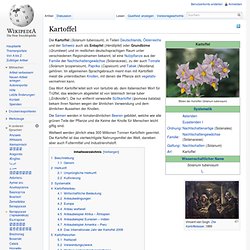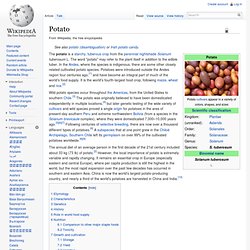

Potatoes. An Important Message About Potatoes We have placed nightshade vegetables (such as potatoes) on our "10 Most Controversial WHFoods List.

" This list was created to let you know that even though some foods (like potatoes) can make an outstanding contribution to your meal plan, they are definitely not for everyone. Nightshade vegetables can be difficult to find in high-quality form; can be more commonly associated with adverse reactions than other foods; and can present more challenges to our food supply in terms of sustainability. More details about our 10 Most Controversial WHFoods can be found here. About Potatoes Whether mashed, baked or roasted, people often consider potatoes as comfort food. The potato belongs to the Solanaceae or nightshade family whose other members include tomatoes, eggplants, peppers, and tomatillos.
Potatoes, baked1.00 medium(173.00 grams) NutrientDRI/DV phosphorus17.3% Health Benefits Potatoes are a very popular food source. Blood-Pressure Lowering Potential History. Kartoffel. Das Wort Kartoffel leitet sich von tartufolo ab, dem italienischen Wort für Trüffel, das wiederum abgeleitet ist von lateinisch terrae tuber („Erdknolle“).

Die nur entfernt verwandte Süßkartoffel (Ipomoea batatas) bekam ihren Namen wegen der ähnlichen Verwendung und dem ähnlichen Aussehen der Knollen. Weltweit werden jährlich etwa 300 Millionen Tonnen Kartoffeln geerntet. Die Kartoffel ist das viertwichtigste Nahrungsmittel der Welt, daneben aber auch Futtermittel und Industrierohstoff.
Beschreibung Unterer Teil einer Pflanze. Früchte der Kartoffelpflanze Kartoffeln sind aufrecht oder kletternd wachsende, krautige Pflanzen, die über 1 m hoch werden können. Die Keimung erfolgt epigäisch. An den basalen Teilen des Sprosses treiben Achselknospen aus, die in den Boden eindringen und dort waagrecht (plagiotrop) ausläuferartig weiterwachsen und zu den Stolonen werden. Genom Herkunft Ursprüngliche Herkunft Kultivierung Kartoffelernte in der DDR Systematik Kartoffelanbau Wirtschaftliche Bedeutung. Potato. The potato is a starchy, tuberous crop from the perennial nightshade Solanum tuberosum L.

The word "potato" may refer to the plant itself in addition to the edible tuber. In the Andes, where the species is indigenous, there are some other closely related cultivated potato species. Potatoes were introduced outside the Andes region four centuries ago,[1] and have become an integral part of much of the world's food supply. It is the world's fourth-largest food crop, following maize, wheat and rice.[2] The annual diet of an average person in the first decade of the 21st century included about 33 kg (73 lb) of potato.[2] However, the local importance of potato is extremely variable and rapidly changing. Etymology The English word potato comes from Spanish patata (the name used in Spain). The name spud for a small potato comes from the digging of soil (or a hole) prior to the planting of potatoes.
Characteristics Flowers of a potato plant Russet potatoes with sprouts Potato plants Genetics History. Solanum tuberosum. Solanum tuberosum [edit] Familia: Solanaceae Subfamilia: Solanoideae Tribus: Solaneae Genus: Solanum Species: Solanum tuberosum Name[edit] Solanum tuberosum L.

References[edit] Linnaeus, C. (1753). Vernacular names[edit] العربية: بطاطسBoarisch: Erdo(ä)pfé, Grumpirn, Kartófféбългарски: Картофcatalà: Patataсрпски / srpski: Кромпир, Krompirdansk: KartoffelDeutsch: Kartoffel, Erdapfeleesti: KartulEnglish: Potatoespañol: Papa, Patatafrançais: Pomme de terre, patategalego: Pataca, Balocaitaliano: Patatalatviešu: kartupelisмакедонски: Компирമലയാളം: ഉരുളക്കിഴങ്ങ്Nordfriisk: Iartapel, Eerdaapel, Irpelportuguês: Batata, batatinharomână: Cartofsuomi: perunasvenska: potatisTürkçe: Patatesукраїнська: Картопля.
Solanum tuberosum (Potato)